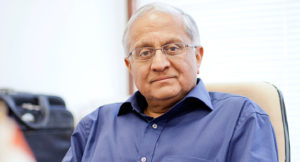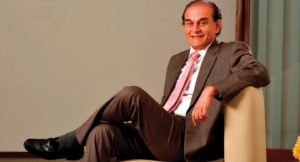Narayana Health’s Dr. Devi Prasad Shetty wants to rewrite India’s healthcare story. His personal mantra: it is pointless talking about all the advancements in healthcare if people cannot afford it

While I was waiting for Padma Bhushan Dr. Devi Prasad Shetty, founder and chairman, of Bengaluru-based Narayana Health (NH), in his conference room, a quote caught my attention. It read: “Healthcare is all about process, protocol and price.” Incidentally, this quote reminded me of a book I read a few weeks ago. The book, titled, Reverse Innovation, and authored by Professor Vijay Govindarajan and Chris Trimble, focuses on the changing dynamics of global innovation and how innovation will not traverse the globe in only one direction, from developed nations to developing nations, but will also flow in reverse.
The book highlights work done by several leading companies from around the world, and Narayana Health (erstwhile Narayana Hrudayalaya) was highlighted for its process innovation. It went on to explain how the company lowered the cost of an open-heart surgery (compared to costs and prices in the West) and why it was able to do that. The reason for the lower cost was not only because of the labour arbitrage, but also because it utilised its medical equipment and doctors much more efficiently. The book then went on to highlight how Shetty plans to take this innovation done in India, in reverse, to the Western market. While it is common knowledge that Shetty believes in providing affordable healthcare to all, the way he went about translating his vision into execution, could serve as guidance for many entrepreneurs, especially for those in the healthcare sector.
A visionary and a man who is on a mission to make healthcare affordable to the masses living in emerging economies, Shetty left England in 1989 to start his career in Kolkata. At that time, he used to see over 100 patients daily, but very few of them turned up for an operation, as a bypass grafting would cost Rs. 1.50 lakh. That’s when he realised, it is pointless to talk about all the advancements in healthcare, if people cannot afford it. So, at a very early stage, he decided that the cost of healthcare had to come down. But, charity was not his solution. In 2001, he setup NH in Bengaluru, and eventually expanded across the country, with clear processes in place, to achieve the prime goal of providing affordable healthcare to all. As Govindarajan and Trimble state in their book, NH took the radical step of implementing into healthcare, a number of well-understood industrial concepts that have been around since Ford’s Model T: standardisation, specialisation of labor, economies of scale, and assembly line production. In 2011, he was recognised for his efforts of lowering healthcare costs by mass production and won the “Business Process Award” from The Economist Magazine in London.
According to NH practices, a very important aspect in keeping the costs low is to monitor and measure it regularly. It has implemented an Oracle ERP on cloud that provides detailed information on a real time basis. For instance, by noon daily, the team gets the previous day’s revenue, expense and the estimated EBIDTA margins. “For us looking at the profit and loss account at the end of the month is like reading a post mortem report. We cannot take much action during the month. But getting it on a daily basis is a diagnostic tool. We can change a lot of things,” says Shetty.
![]()
However, the hospital’s greatest contribution to the healthcare sector is about how it put to use these process innovations, performed a large number of surgeries and most importantly, created the awareness that a heart surgery can be affordable to the common man. Today, twenty-four years since Shetty started operating, NH is able to break even with Rs. 90,000 for a heart operation from Rs. 1.5 lakhs then and he wants to bring it down to US $800 (approximately Rs. 48,000) in the near future.
Shetty also aims to add 30,000 beds (from the current 6,000 beds) in the next seven to ten years, as he believes that the country requires close to two million beds and does not foresee the government providing it. “Adding just 1,000 to 2,000 beds is not going to make a difference. The need is just tremendous,” reinstates Shetty.
To achieve such numbers, he is willing to explore multiple options such as management of hospitals (where NH would take management contracts of hospitals owned by others), setting up low-cost hospitals (not only low-cost surgeries, but the cost of buildings and running the hospitals itself will be low), running embedded centers, and forging joint ventures, while continuing to deliver on NH’s low cost approach, as the company scales up.
Increasing the bed count
By setting up low-cost hospitals
Typically, setting up a 300-bed super specialty heart hospital in major cities costs Rs. 150 crore to Rs. 200 crore, and is not an economically viable mode of operation to achieve Shetty’s dream number. Hence, he came up with the concept of low-cost hospitals, which he can set up at just 25 per cent of the normal cost. In early 2013, NH began operations of its first low-cost hospital in Mysore in partnership with Government of Karnataka, which has a 26 per cent stake in it.
“Our joint venture in Cayman is bestowed with significant advantages that come in from two strong business partners-one with a significant US presence and process rigour and the other partner with an affordability-based delivery model,”
– V Kesavan, group chief financial officer
“We worked with L&T to build a 300-bed super specialty hospital for US $6 million (Rs. 35 crore) and completed the project in 8 months as against the normal time period of three years,” says Shetty. This was possible because the hospital was a ground floor construction, which helped save around Rs. 100 per square feet on piling, foundation and fire clearances. Moreover, only the intensive care units and the operation theatres had air conditioning, which resulted in further savings of Rs. 150 per square foot.
Going forward, Shetty indicates that there are hundreds of towns in India with a population of 500,000 to one million where there are no heart hospitals. Over the next few years, NH targets to build this kind of easily replicable low cost model in such towns and Tier 3/Tier 4 cities.
Expansion through other models
The hospital will look at all kinds of collaborations, associations and tie-ups to achieve the kind of scale it is looking to build. One form of collaboration is taking over the management of poorly run hospitals. For example, NH got into a contract to manage the MMI Hospital in Raipur, Chhattisgarh. Since then, it has increased the number of beds in the hospital, introduced health packages to enhance preventive health care, equipped the radiology department with latest equipments and upgraded the emergency and trauma care centre. It is also in the process of taking over and running an operational heart centre. Moreover, NH also manages cardiac centres attached to medical college hospitals like SS Medical College, Davangere and SDM Medical College, Dharwad, to name a few. The Durgapur Medical College in West Bengal is entirely managed by NH.
“To achieve a low cost model in healthcare, unlike in any other industry, you have to have as good quality as you can produce. There is a general perception among people that if you have low costs it means low quality as well. However, our essential ingredient is quality,” – Dr. A Raghuvanshi, vice chairman, MD and group CEO
![]()
Secondly, based on enquiries, the management approaches organisations/individuals interested in partnering with them, to build hospitals in locations that is of interest to them. While the organisations/individuals make the investment in land and building, NH invests in the medical assets. NH shares the revenues for the land and building portion of partners’ investment in the project. Two such hospitals are coming up in Whitefield and HSR layout in Bengaluru and will become operational in July. “The revenue share is based on the location credentials and on the amount of investment made in land and building,” states V. Kesavan, group chief financial officer of NH. While the investment in land is very subjective, from a building perspective, approximately Rs. 3,200 per square feet is the cost for establishing the infrastructure in Bengaluru.
Thirdly, it has also setup embedded heart centers in other hospitals such as Chinmaya Mission, MS Ramiah Mission and St. Marthas, on a revenue sharing model, where the civil infrastructure is already present and the hospital infrastructure specific to heart and specific specialisations need to be set up. It recently inaugurated a similar centre at West Bank Hospital in Kolkata.
The reverse innovation play
NH has recently entered into a joint venture with American not-for-profit healthcare group, Ascension Health Alliance (where NH holds around 28 per cent), to build a tertiary care hospital with 100 to 120 beds in the Cayman Islands, which will cover the Caribbean region too. “Patients from this area currently go to the U.S. for their treatment and suffer with respect to time, visa restrictions and connectivity. We expect to eliminate this pain point,” states Kesavan. Additionally, the Cayman Islands is a one-hour flight from Miami, Florida and can potentially serve the U.S. market as well.
Joint ventures work well when you leverage on the partner competencies and strengths including market intelligence, processes and its efficiencies and Ascension’s strength is its supply chain management. “Our joint venture in Cayman is bestowed with significant advantages that come in from two strong business partners-one with a significant US presence and process rigour and the other partner with an affordability-based delivery model,” adds Kesavan.
Working on lowering the cost of healthcare
Getting IT right for low cost
To achieve the low cost model, the hospital has adopted multiple strategies. However, Dr. A Raghuvanshi, vice chairman, MD and group CEO of NH, highlights a very important point. “To achieve a low cost model in healthcare, unlike in any other industry, you have to have as good quality as you can produce. There is a general perception among people that if you have low costs it means low quality as well. However, our essential ingredient is quality,” says he.
Achieving quality in healthcare means that the systems and processes of the hospital should be streamlined. This helps reduce cost as there is lower rate of error, patients go home faster and the material required is comparatively lesser. NH has clearly defined systems, processes and protocols in place and it is called the NH way. The team is in the process of creating a document, which will almost be like a constitution that will define how it should function. “This is not necessarily with reference to the clinical protocol. It is also in the way a patient is received, transferred from one place to the other and how the medicines are indented,” says Raghuvanshi. All this can be achieved with the help of technology and, hence, NH’s IT systems play a very important role.
According to NH practices, a very important aspect in keeping the costs low is to monitor and measure it regularly. It has implemented an Oracle ERP-on-cloud that provides detailed information on a real time basis. For instance, by noon daily, the team gets the previous day’s revenue, expense and the estimated EBIDTA margins. “For us looking at the profit and loss account at the end of the month is like reading a post mortem report and we cannot take much action during the month. But getting it on a daily basis is a diagnostic tool. We can change a lot of things,” shares Shetty. All its important stakeholders, including the doctors, get information on a very regular basis about profits and losses happening on a particular service or a type of operation. “Just the knowledge and information on the cost of their procedures will make the doctors more careful and sensitive to costs,” states Raghuvanshi.
Counting on numbers
Across the NH network, there are 281 doctors handling cardiac surgery and cardiology (81 are students) performing over 40 surgeries a day. “When you hit that kind of number, the cost automatically comes down. If you are doing two surgeries in a day, you cannot reduce the cost,” opines Shetty. He and his team have performed over 86,000 major heart surgeries so far, out of which 15,000 operations were on children, many of them new born babies.
NH uses its infrastructure for 12 to 14 hours a day. Normally, hospitals do not run services such as operation theatres and cath laboratories for more than 8 hours. NH realised that the CT scan and high-end MRI machines need to be used to the maximum to get the advantage on the capital deployed. The average number of CT scans done per machine in the country will not be more than 5 to 7 per day whereas NH tries to do at least 30 CT scans per day. “And for that, just the cardiac patients using it will not be sufficient. That is the reason we spread to a multi-specialty kind of mode,” states Raghuvanshi.
Currently, NH is one amongst a few hospitals that performs the largest number of heart surgeries in the world. And as 30 per cent of the cost in a hospital goes towards materials, NH has strategies in place to achieve economies of scale even here. Dr. Shetty explains, “10 per cent of heart surgeries done in India are done by us. So when we become a client to any company which makes products for heart surgery, they capture 10 per cent of the market.” For example, in the case of valve replacement surgeries, NH implants the largest number of heart valves in the world and any valve manufacturing company around the world would give the products at a lower cost to NH.
The hospital also has a centralised purchase unit. “We standardise the products that we keep on our shelves. Almost 95 per cent of the inventory is standardised across all the hospitals. Just 5 per cent is left to the local hospital to buy,” states Raghuvanshi.
NH hires its own people as all its hospitals have academic institutions where it trains specialists like heart surgeons, cardiologists and nephrologists. “So when you have a large training program, you have large number of residents who are very passionate and will be working with you for 3 to 4 years. And when they graduate they will join our own institution somewhere,” shares Shetty.

The NH Journey
Shetty set up NH Health City in Bengaluru in the year 2001. It currently operates on a Greenfield model and with global firms, J.P. Morgan and American International Group (who have put in Rs. 200 crore each) as its investors.
In just over 12 years of its founding, today NH group currently has a capacity of 5,647 beds (this is including 2,400 beds at Bengaluru Health City) across 17 hospitals in 13 cities all under one brand – Narayana Health. The cities in which it is present currently are Bengaluru, Kolkata, Hyderabad, Jaipur, Ahmedabad, Raipur, Jamshedpur, Mysore, Shimoga, Kolar, Dharwad, Davangere and Durgapur. Hospitals at Guwahati, Bhubaneswar, Whitefield and Cayman Islands are at different stages of completion and commissioning. Its financial performance is commensurate with its growth. Its revenues have grown from Rs.148.88 crore in FY08 to Rs. 649.43 in FY12. For the fiscal year ended March 2013, its revenues have grown by around 30 per cent. While Bengaluru and Kolkatta accounts for a large proportion of revenue at NH, the hospitals that are coming up at other locations will steadily improve in terms of proportion of the total revenue.
In Bengaluru and Kolkata, the hospital started operating in cardiology as its first specialty and later commenced neurology and nephrology in Bengaluru and Kolkata respectively. But, NH wanted to establish itself as a general healthcare provider with a focus on tertiary quality care at an economical price point. Raghuvanshi says, “People were surprised to know that we do kidney care as well. We are probably one of the largest providers of dialysis in the country today.” Across the network, NH has 240 dialysis machines and does about 1,00,000 dialysis every year.
To overcome this and create an image of a multispecialty hospital, it changed its name from Narayana Hrudayalaya to Narayana Health. “When you say Narayana Hrudayalaya, it is obvious that we are into heart care. All these years, we didn’t want to change it because the original objective was to say that it is from the heart,” says Shetty. But now, the hospital decided that it was time to reestablish that identity and create a brand which people understand. Currently, it has all specialties with specific focus on tertiary care like nephrology, organ transplant, neurology sciences and cancer care.
“Another reason for the name change is that in places like Jaipur, people find Hrudayalaya very hard to pronounce. We felt it will be easier to moderate it and change the name to health,” adds Shetty.
Treatment for all
Essentially, NH does not refuse treatment to any patient citing cost as the reason. Interestingly, Shetty notes, that while in Karnataka, there are enough donors to subsidise the treatment costs for patients, we have no local patients who are in need of it, as most of them are a part of insurance schemes such as The Karnataka Yashaswini Health insurance scheme for rural farmers, Arogyashri Yojana for families living below the poverty line or patients referred by ESIC. For those who are not a part of such schemes, NH has a charitable wing that raises funds for treatment.
Ten years ago, Shetty played an instrumental role in helping the Karnataka state Government to launch Yeshashwini Micro Health Insurance scheme, the largest Micro Health Insurance programme in the world for farmers. “Now we have 4 million farmers who have paid Rs. 10 per month and are entitled to any type of operation, including heart surgery,” states he. Today, there are four to five such schemes in Karnataka. He has also proposed to the National Innovation Council to provide health insurance to mobile subscribers in the country by paying just Rs. 20 per month as insurance premium. “We are trying to convince the policy makers about it. We have close to 850 million mobile subscribers who are spending about Rs. 150 per month just to speak on the mobile phone. We want to see if there is some way of collecting Rs. 20 out of that,” says Shetty.

Not without challenges
“We do not have that many inherent internal challenges in the organisation,” says Raghuvanshi, “but we find that the changes in the external environment lead to bigger challenges.” Lack of manpower – doctors, nurses and paramedical staff – is the biggest challenge for NH. There are only about 12,000 medical post graduation (PG) seats in this country which are for clinically relevant subjects but there are about 48,000 students who do their MBBS course. “So, half of them cannot get PG admission. When they get into a medical school, they want to become a surgeon or a physician but they do not have that opportunity,” observes Raghuvanshi. It is just not that. There is a shortage of almost two million doctors in the country and, according to him; this issue is not getting addressed. He agrees that there are some limited steps which the authorities are taking, but says that it not sufficient. Through the National Skill Development council, the Government is also trying to develop curriculum for training paramedical workforce.
According to Shetty, there are several regulatory changes required in the country. Karnataka has managed to make some changes. For instance, when a patient stays in the general ward, the per day electricity charges per bed is high. “This is because hospitals are clubbed with the entertainment industry. That is why we pay Rs. 7 per unit while industries pay Rs. 5 per unit,” says Shetty. He continues, “The government has now created a separate category for us. It happened in Karnataka state and I hope it happens in other states as well.”
Another big challenge that Shetty faces is the capital cost. “Today capital comes with a huge price tag if you need to scale up the operation,” says he. While an initial public offering is too soon to talk about, NH may look at debt instruments for further injection of funds, which may be needed two to three years down the line due to its scaling up plans.
Managing the workforce
Managing doctors is always a problem in most healthcare organisations. And things are not very different for NH, but, the hospital has practicing clinicians as well, who are a part of the management, which makes things comparatively easy for the hospital. Shetty, even today, sees almost 50 to 60 patients and does at least one or two operations every day. Raghuvanshi, a cardiac surgeon, was operating regularly until two years back. “When we talk to our doctors they have a different equation with us. They know that we understand their problems a little better than an administrator,” states Dr. Raghuvanshi. Having said that, he adds, “When you start operating in such a large scale, a disconnect starts setting in. That’s quite natural. There is a kind of mistrust between the doctors and administrators. But due to our experience, we are able to somehow bring these two sides together.”
The hospital has taken a few measures to address this problem. It has standardised the products it uses. “A group of clinicians work together, analyse a particular medicine, identify brands, costs, etc and they take the decision on such matters. They are participating in decision making and feel they are a part of the team,” states Dr. Raghuvanshi. There is no pressure in the work environment, as the management does not question the doctors on the number of cases they have performed. “NH is also popular with doctors who have been working abroad. If doctors working in the U.S. or U.K. want to relocate to India, they always try to see if they find an option with us,” says Raghuvanshi.
The ten-year plan
Apart from taking measures internally to reduce costs through innovative processes, Shetty is convinced that at a macro level, the cost of all aspects of healthcare will come down – be it cost of the building, tax structure or customs duty on equipments. He is also certain that the cost of medical equipment will come down by at least 50 per cent. “There is going to be a huge competition to the established players in the medical industry from new entrants like Samsung. Samsung wants to be the largest medical equipment manufacturer by 2020,” he says.
And this makes the NH team believe that India will become the first country in the world to disassociate healthcare from affluence. And it will play an important role along with the other hospitals in making it happen. And to achieve this, Dr. Shetty, aims to add 30,000 beds in about 7 to 10 years and is hopeful that, by then, NH would be instrumental in bringing down the cost of a heart surgery to US $800. “We believe that 10 years down the line we will still have millions of people living in slums with no amenities. But when they are unwell, they will have access to high tech healthcare with dignity. India will prove to the world that the wealth of the country has very little to do with quality of healthcare,” concludes Dr. Shetty.
SHETTY’S COMMENT ON THE HEALTHCARE SECTOR
While the 20th century economy was driven by machines, which addressed the human toy, the 21st century will see the healthcare sector leading the pack. Today, global healthcare and wellness is the second largest industry ($ 4.5 trillion) in the world after the agro industry. Despite spending so much, less than 10 to 20 per cent of the population has access to secondary and tertiary healthcare. Imagine how big it will become when the whole world has access to such healthcare. But the problem is, it is mostly run as a mom and pop operations and is fragmented. There are no economies of scale and no IT penetration. In all the hospitals, IT is used to generate bills and control inventory. It is not used for healthcare. But, if IT penetrates beyond this, many changes will happen. Processes and protocols will drive entire patient care. Every interaction between the doctor and the patient or nurse and the patient will happen through an iPad. These are the transformations we are bringing about in this hospital. For instance, there is an interactive software company called IKare which Narayana Healthcare, Sam Pitroda of National Innovation Council and Cognizant Technologies have started together. Through this software, we are in the process of replacing the ITU chart in the intensive care unit.
SHETTY’S TYPICAL DAY
I start my day early with a regular exercise regimen. In my medical school days, I was very much into sports, games and martial arts. Now it is restricted to treadmill and EFX. I strongly believe that you cannot do anything in this world without multitasking. If you are doing one thing at a time that means you are being inefficient. So, when I am on the EFX, I finish all my dictations on the iPad and this saves a lot of time. That’s also the reason I am having lunch and talking to you!
I work for about 14 to 16 hours a day, six days a week and most of my colleagues work longer. Our patients go to the operation theatre by 6 in the morning and surgeries go on till 8 or 9 in the night. I don’t get into the administrative side of the hospital. I see patients and I love operations. This is my passion. I would like to remain a heart surgeon.
HIS LEARNINGS FROM MOTHER TERESA
When you are a doctor, you don’t like to believe that somebody else with flesh and blood, like you, can be God. I can tell you that Mother Teresa is not like us. She is something different. When you are in her presence, you feel the divinity. What I learnt most from her is humility. In this world, you can never get anything without humility and that is her most important quality. She also had a very clear understanding of life and her responsibilities. She being a religious woman, one would have thought that she would just pray to God. But, she believes that helping people is more sacred than praying to God. Her very famous statement is, “Hands that help are more sacred than the lips that pray.”
SHETTY’S TAKE ON TELEMEDICINE PROGRAMME
The entire concept of telemedicine has undergone a dramatic change. 10 years ago, when there was satellite link up through the ISRO satellites, I had to go to the 7th floor of the building to see the patient in a remote location. Today, owing to applications like Skype, I see them from wherever I am and provide consultations. This way, we have treated over 53,000 patients in different locations, free of cost. We look at telemedicine more as a tool that provides a technological advantage to enhance medical procedures, than as a revenue generating activity. For instance, when we started liver transplants on children, we didn’t have the expertise in anesthesia on children, for this surgery. So, the anesthesia for the first five transplants was given by the children’s hospital of Philadelphia (U.S.), through satellite.
LOWERING MEDICAL COSTS THE NH WAY
- Streamline the systems and processes
- Increase the number of surgeries. Achieve scale.
- Use infrastructure for 12 to 14 hours
- Amplify the role of technology in systems and processes
- Have a centralised purchase unit
- Monitor and measure costs regularly
- Build low cost hospitals primarily on the ground floor and provide air conditioning facilities only in the intensive care units and the operation theatres






